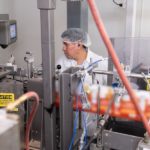By: Mike Aykroid, Manager of Strategic Partnerships at GreenSeed Contract Packaging
Record global inflation, warehouse space shortages, and sustained supply chain breakages have upended CPG operations in the past few years. Short-term fixes have helped mitigate the impacts, but there are more sustainable, longer-term strategies that provide immediate benefits while future-proofing operations for suppliers and CPG companies alike.
We’re all familiar with the short-term workarounds that CPGs may turn to when prices rise: shrinkflation (giving less product for the same price), substituting an alternate supplier or ingredient, or suffering through thinner margins due to higher COGs, until prices and costs stabilize. At the same time, consumers tend to respond to inflation by overbuying/hoarding in an attempt to outrun price increases, flocking to generic brands or private label goods, or cutting back altogether. When prices stabilize, both operations and consumer behavior change again.
The pandemic and the resulting economic swings have been extreme, to say the least. Still, there will be another economic cycle, world event, or weather occurrence that will affect some part of the supply chain. The silver lining of supply chain backlogs is the information we gained—we saw the global weaknesses and vulnerabilities thrown into sharp relief. This information represents an opportunity for suppliers and manufacturers to put new, foundational practices in place to ward off future issues and create systems of success.
A foundation for future-proofing
This is a period of renewal. Rather than plug and play old solutions when we face challenges in the future, we can build a new foundation for growth with these five steps:
Adopting a growth mindset
The growth mindset is a concept championed by Carol Dweck, originally in the educational setting and later in the workplace. Growth mindset companies view challenges as opportunities and learn and adapt from mistakes and missteps—while “fixed mindset” companies view challenges as nothing more than challenges. According to the Harvard Business Review, employees in a “growth mindset” company are:
47% likelier to say that their colleagues are trustworthy
34% likelier to feel a strong sense of ownership and commitment to the company
65% likelier to say that the company supports risk taking, and
49% likelier to say that the company fosters innovation.
Taking a long-term view
We have the ability to reduce costs in CPG manufacturing. The solutions require a long-term view and long-term commitments. Whether it’s a different production process or a different packaging approach, it’s easier to create efficiencies with extended commitments. Some CPG companies are already leading the charge with efforts to reduce their environmental footprint, for example, and viewing the longer-term impacts of today’s decisions. Widening the lens to look not just at a single production cycle, but a series of cycles over time, can potentially provide ongoing cost reductions that benefit all stakeholders in the value chain.
Employing a Think Tank approach
Manufacturers and suppliers need to have a seat at the same table. While CPG leaders regularly convene to discuss best practices and challenges, there is additional opportunity to include manufacturers, co-manufacturers, and contract packagers in these same discussions (and vice versa for manufacturer conventions and meetings). A Think Tank approach means representatives from both sides meet to go over five-year growth plans, projections, contingencies, and so on. This proactive dialogue fosters high-level thinking and more strategic solutions. Then when new challenges present themselves, leaders are already prepared with answers.
Maintaining a disciplined innovation process
With the unpredictable nature of the supply chain, it’s natural that leaders will get pulled into an emergency or challenging customer situation and need to put out fires. Still, if that fire-fighting mentality becomes standard practice, the manufacturer/supplier partnership becomes task oriented rather than solution oriented, which is far from ideal. A disciplined innovation process with a long-term view allows leaders to move out of emergency mode and back into proactive planning more easily and effectively.
Seeking continuous improvement
Back to the growth mindset, solutions are never “one and done.” Continuous improvement means reflecting, reviewing, and resetting. We’re always looking for ways to innovate, whether it’s automation, scheduling, or upskilling. The “stop fixing and start improving” mantra of continuous improvement gets manufacturers and suppliers out of reactive scrambling mode and into an effective process of insights, planning, and action. We’ve learned from past recessions that companies that respond quickly and invest for future growth are more likely to recover faster than competitors and thrive as conditions become more favorable.
The inflation rate in the U.S. quadrupled from 2020 to 2022. We’re still managing through previous supply chain weaknesses and recessionary conditions on multiple continents. Consumer demand is sporadic and unpredictable, especially in the face of inflation. Putting these five practices in place provides armor for what’s to come. Rather than plugging holes in the dam as they burst open, we can build a stronger, more resilient dam altogether.
Mike Aykroid is Manager of Strategic Partnerships at GreenSeed Contract Packaging and a food processing and packaging industry veteran responsible for providing large to mid-level CPG companies with quality, customized external packaging using forward-thinking research and development (R&D) insights, certified processes, data metrics and best practices.














